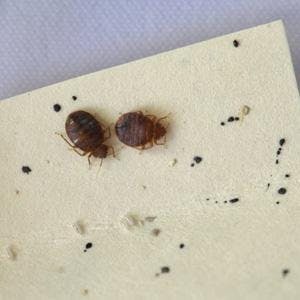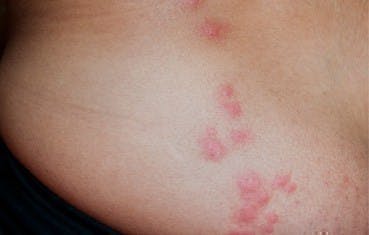Top five things to know about bed bugs
Most people would prefer not to think about bed bugs. After all, they’re the nightmare of city dwellers, are known to be exceptionally difficult to get rid of, and can cause months of inconvenience. Not to mention, they’re just plain gross. However, armed with the right knowledge, you can prevent and battle bed bugs effectively. Here, we’ll be sharing the top five things you need to know about bed bugs:
- What are bed bugs?
- Where are bed bugs typically found?
- What are the symptoms of bed bug bites?
- What are the treatment options for bed bug bites?
- How do I prevent bed bug bites?
Let’s dive in.
1. What Are Bed Bugs?
To prevent bed bugs, you first need to be able to identify them. According to the U.S. Environmental Protection Agency (EPA), bed bugs are insects that are generally:
- About the size of an apple seed.
- Long and brown with a flat, oval-shaped body when not recently fed.
- Balloon-like, reddish-brown and elongated when recently fed.
- Smelly, with a “musty-sweetish” odor.
- Bed bug nymphs (young bedbugs) are smaller, translucent and whitish-yellow.
- Bed bug eggs are tiny and pearl-white.

Bed bugs are a nuisance to humans because they prefer to feed on human blood, and in the process cause itchy, uncomfortable bites as well as a great deal of distress. The good news is that bed bugs are not known to spread disease. The bad news, though, is that bed bug numbers are only rising in the U.S.
This may be due to a variety of reasons, from increased air travel to growing urban populations. No matter the cause, though, the fact is that bed bugs are now a reality for people across the U.S.
2. Where Do Bed Bugs Hide?
According to a 2018 survey from the National Pest Management Association, pest professional report the most common bed bugs dwellings are single-family homes (91 percent of pest professionals report this), apartments/condos (89 percent of pest professionals report this) and hotels/motels (68 percent of pest professionals report this ). However, bed bugs can also be found in:
- Nursing homes (59 percent of pest professionals report this).
- Schools and daycare centers (47 percent “’).
- Office buildings (46 percent “”).
- College dorms (45 percent “’).
- Hospitals (36 percent “’).
- Public transportation (19 percent “’).
In terms of specific cities, pest control company Orkin named these cities as the top ten bed bug cities in the U.S. for 2019:
- Baltimore
- Washington, D.C.
- Chicago
- Los Angeles
- Columbus, Ohio
- New York
- Cincinnati
- Detroit
- Atlanta
- Philadelphia
As their name indicates, bed bugs are most typically found in and around beds, as well as other types of furniture. If you’re looking for bedbugs in your home, be sure to check the seams of all your upholstered furniture, around your entire mattress and box spring and in any crevices of your bed frame.
Remember to check tags, piping and any cracks, too — according to the EPA, if a crevice is big enough to hold a credit card, then it can serve as a bed bug hiding place.
Less commonly, bed bugs can also be found:
- In the folds of curtains.
- In drawer joints.
- Underneath loose wallpaper and wall hangings.
- Inside appliances.
However, those hiding spots are usually only used in especially bad infestations. If you live in or are traveling to any of the cities mentioned in this section, it’s a good idea to be extra vigilant about checking for unwanted guests.
3. What Are the Symptoms of Bed Bug Bites?
Wondering if you’ve got a bed bug infestation? While the best evidence is actual bed bug sightings, you can also look at the characteristics of your bites.
According to the U.S. Centers for Disease Control and Prevention (CDC), bed bug bites:
- Resemble those of a mosquito or flea.
- Are comprised of a slightly swollen and red area.
- Tend to itch and cause irritation.
- May appear either in random patterns or in a straight line.

Image source: American Academy of Dermatology, AAD.org, “Bed bugs”
However, some people may not experience any of these symptoms or may experience symptoms of an allergic reaction, such as enlarged bite marks, painful swelling, or even anaphylaxis. At the end of the day, the only way to find out if you have bed bugs is to find them and have them identified by a pest control professional.
Still not sure if what you’ve got are bed bug bites, our providers can help diagnose what you have and help you get the appropriate treatment.
4. What Are the Treatment Options for Bed Bug Bites?
If you’ve confirmed that your bug bites are indeed being caused by bed bugs, your next question will probably be about how to treat your bites. Luckily, bed bug bites can be treated relatively quickly and easily, either at home or with the help of a medical professional.
To treat your bites at home, be sure to regularly wash them with soap and water to relieve itchiness. If the itching persists, try applying an over-the-counter corticosteroid cream as directed.
If you’re experiencing a large number of bites, blistering, an infection or an allergic reaction (characterized by enlarged bites, painful swelling or anaphylaxis), it’s time to see a doctor.
Your doctor may treat your symptoms by:
- Prescribing an antihistamine or corticosteroid to reduce itchiness.
- Recommending an antiseptic to address superficial infections.
- Prescribing a course of antibiotics for more severe infections.
- Administering an anti-allergy injection of a medication like epinephrine for more severe allergic reactions.
5. How Do I Prevent Bed Bug Bites?
The only way to prevent bed bug bites is to prevent bed bug infestations themselves.
Here are some ideas:
- Thoroughly check secondhand furniture before bringing it into your house.
- When traveling, inspect your lodgings upon arrival, paying special attention to the bed and bedroom area. Store your luggage away from walls and furniture.
- When returning from a trip, check your luggage for bed bugs before unpacking. To be extra careful, vacuum your luggage.
If you do find bed bugs in your home, the best thing you can do is act immediately by contacting your landlord or a pest control company.
For help addressing any bed bug bite symptoms, remember that you can always stop by your nearest Urgent Care center. Our caring providers can quickly give you the treatment you need.


